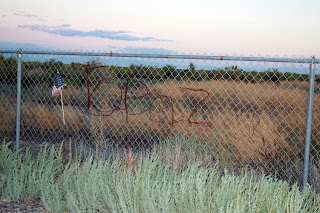December 7, 1941 – A day that will live in infamy. For a generation of Americans this date still has as much resonance today as September 11, 2001 does for most of the country.
Considered to be one of nation’s darkest moments
and triggering America’s entry into World War II, the bombing of Pearl Harbor
also set in motion perhaps one of the lowest points in our nation’s history for
another reason, the imprisonment of thousands of Japanese American citizens for
no better reason than their ancestory.
No matter how it is labeled - relocation or internment – it still
remains one of the worst civil liberties violations in our nation’s
history. As the country fought to
defend liberty and freedom abroad on the home front fear and racial prejudices
won with the passing of executive order 9066 and the forced imprisonment of
Japanese Americans in the name of national security.
 Being
able to confront this ugly truth and recognizing this injustice is a valuable
part of the healing process while honoring those who suffered. Each year the
National Park Service awards grants for scholarly work to record the story of Japanese
American internment and the documentation of the camps where these events took
place. Through this grant program I was able to participate as part of an
interdisciplinary team in the digital document and recording of the Topaz
Relocation Center outside of Delta, Utah.
Cyark, a digital scanning and 3-D digital modeling non-profit
organization, in partnership with the University of Colorado Denver utilized
the latest technology to collect data and build a 3-D digital model of Topaz
that will be used on-line to educate the public about the history of the site.
Being
able to confront this ugly truth and recognizing this injustice is a valuable
part of the healing process while honoring those who suffered. Each year the
National Park Service awards grants for scholarly work to record the story of Japanese
American internment and the documentation of the camps where these events took
place. Through this grant program I was able to participate as part of an
interdisciplinary team in the digital document and recording of the Topaz
Relocation Center outside of Delta, Utah.
Cyark, a digital scanning and 3-D digital modeling non-profit
organization, in partnership with the University of Colorado Denver utilized
the latest technology to collect data and build a 3-D digital model of Topaz
that will be used on-line to educate the public about the history of the site. Collecting data for such a large landscape in a remote location proved to be a challenge. Located on land owned by the Bureau of Land Management, the Topaz Internment Camp is roughly a square mile in size. None of the buildings or structures remain on the site, but the camp’s grid system of roads as well as many of the concert foundations remain. Eighty total GPS points were surveyed and acquired throughout the site and served as a base map for the project. Utilizing these fixed satellite points provided the needed reference data for building the 3-D model and placing it into an accurate geographic location. At each of these points high-tech lidar digital scanning equipment was set up to do a 360 degree laser scan at these fixed locations. These scans recorded the site to within millimeters of accuracy and were used to stitch together the 3-D model of Topaz back at the computer lab.
 |
| Main Entrance to Topaz |
Despite the desolate landscape, one could still find evidence of what was once there. The internment camps grid road system framed the site as well as the barrack blocks of the camp. The cement foundations from the mess halls and latrines mark the middle of each block and would have been flanked with six wooden barrack buildings on each side for a total of twelve barracks per block. The repetition of the grid and consistent size of the foundations bares witness to the fact that the site was a military installation and prison. The harsh environment and the harsh reality of the history of this site is hard to escape.
 |
| Baseball Backstop |
While
working at Topaz, the thing that struck me the most were the human touches left
on the landscape that reminded me of the individuals that called this place
home for three years. Despite the
hardships of the landscape, the loss of personal freedom, and awful reality of
the situation there were signs that the internees tried to make the best of a
bad situation. Evidence of
decorative rock gardens and koi ponds could be found in front of the
foundations where many of the barrack buildings once sat. Two backstops for the
baseball fields illustrate a love for the great American past time despite the
fact that the country had turned its backs on these Americans.
 |
| Remnants of a Koi Pond |
Given
the remote location of the Topaz Internment Camp it is doubtful that many
people without a direct connection to the site will make the trip. By working
to document the camp and creating a 3-D model of Topaz that is accessible
online, we hope to bring the site to a larger audience who can take a virtual
tour on their computers. We are often reminded to learn from the past. Hopefully the lessons of Japanese American Internment will not be lost
as we face new fears of national security.


No comments:
Post a Comment